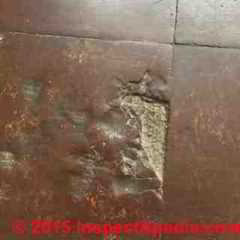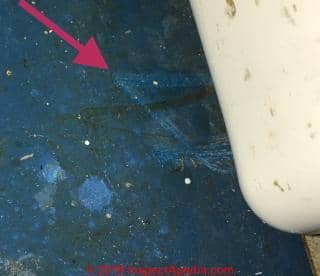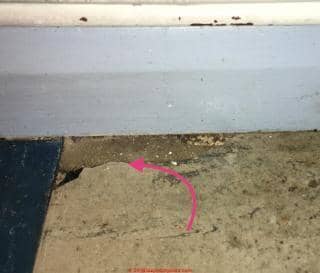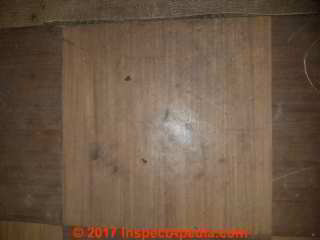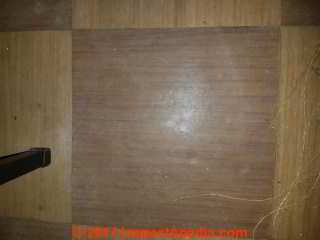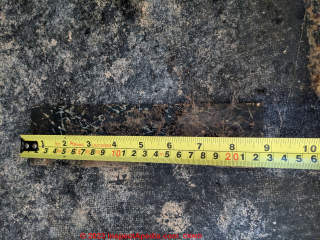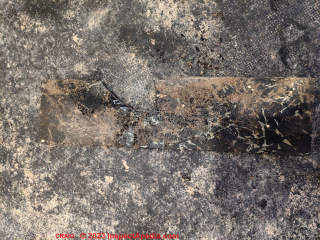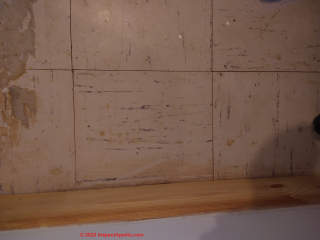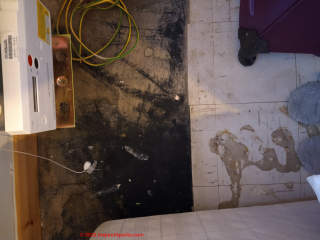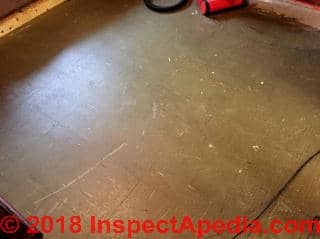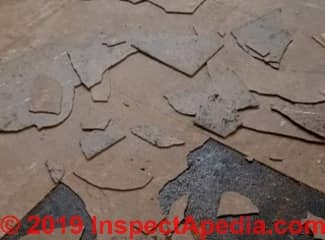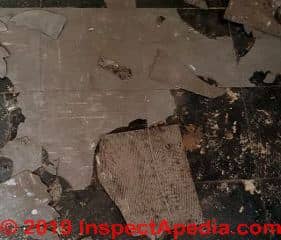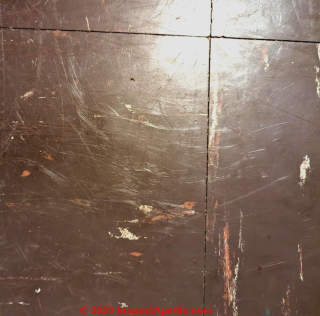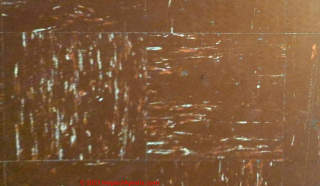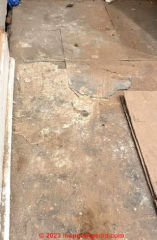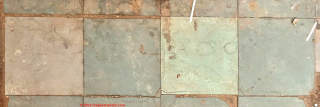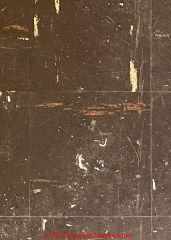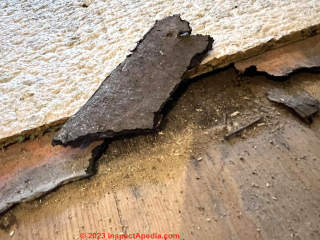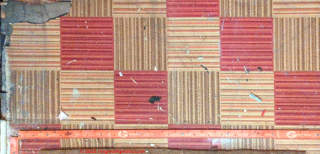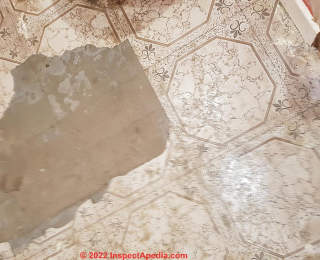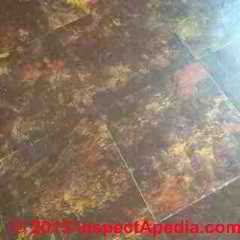 U.K. Floor Tiles / Sheet Flooring That May Contain Asbestos
U.K. Floor Tiles / Sheet Flooring That May Contain Asbestos
U.K. ID Requests
and 9" U.K. floor tiles that do not contain asbestos
- POST a QUESTION or COMMENT about how to identify asbestos-containing flooring materials and what to do when asbestos-containing floor tiles or sheet flooring are found in a building.
Photo ID guide to U.K. asbestos-containing flooring products & examples of U.K. flooring that does not contain asbestos.
This article provides flooring identification requests & photographs & discussion of UK flooring tiles or cottage tiles that may contain asbestos as well as a photo example of non-asbestos flooring.
We also discuss the types of asbestos (chrysotile & amosite) commonly found in asphalt-asbestos and vinyl-asbestos floor tiles and compare that with crocidolite asbestos found in some ceiling tiles and spray-fire-resistant coatings.
This information will assist home owners or tenants in determining if their floors contain asbestos and then to decide what to do about floors in poor condition.
This article series includes a photo-gallery of pictures of floor coverings submitted for identification along with comments on findings, recommendations, & asbestos content. Readers can use our page bottom COMMENT BOX to submit photos of flooring to get help in identifying floor tiles or sheet flooring that might contain asbestos.
InspectAPedia tolerates no conflicts of interest. We have no relationship with advertisers, products, or services discussed at this website.
- Daniel Friedman, Publisher/Editor/Author - See WHO ARE WE?
Asbestos-Containing Flooring in the U.K. & Non-Asbestos U.K. Floor Tiles & Sheet Flooring Identification
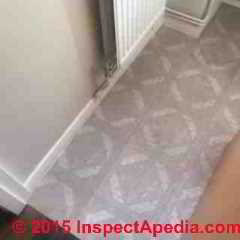 Predominant type of asbestos used in UK Floor Tiles
Predominant type of asbestos used in UK Floor Tiles
Chrysotile (white asbestos) was the predominant form of asbestos used in UK floor tiles, with less-common use of tremolite and actinolite in UK asphalt-asbestos or vinyl asbestos flooring.
Chrysotile asbestos was widely used both in small powder particle form as a filler and in longer fibrous form as a strength reinforcement in both asphalt and vinyl floor tiles in many countries including the U.K. up to 1985.
Asbestos was used in some other forms in buildings in the UK up to 2000.
In the U.K. buildings constructed or renovated before 2000 may have included asbestos-containing products such as drywall, plasterboard, pipe insulation, or vinyl or asphalt-based floor tile or sheet flooring.
According to the U.K.'s Health and Safety Executive, Large amounts of asbestos were used in new and refurbished buildings before 2000. Blue (crocidolite) and brown (amosite) asbestos were banned by law in 1985.
Manufacture and supply of all asbestos was banned by the end of 1999.
Existing asbestos articles can continue in use until they reach the end of their service life. (HSE 2017 cited below).
In the U.K. people who worked in construction, plastering, roofing contractors, pipe fitters, and people who worked in the shipbuilding industry up to the 1980's are at higher risk of developing asbestos-related illnesses such as mesothelioma than are others.
Note that even if asbestos-containing material such as asphalt or vinyl-asbestos flooring is present in your building, that does not necessarily mean that you must or even should remove it. The least-risky course for flooring in good condition is to leave it alone, in place, covering it over with new material.
Asbestos is safe and legal to remain in homes or public buildings as long as the asbestos materials are in good condition and the asbestos can not be released into the air.
Article Series Contents:
- ASBESTOS FLOORING IDENTIFICATION 1950's or LATER in the U.K.
- DOES THIS FLOOR CONTAIN ASBESTOS? 5 easy steps to make a good guess
- U.K. FLOOR TILE & SHEET FLOORING BEFORE 1960 POSSIBLE ASBESTOS
- U.K. FLOOR TILE 9x9" 1963 NOT ASBESTOS
- UK FLOOR TILES & SHEET FLOORING 1970-1985
- UK FLOOR TILES AFTER 1985 BEFORE 2000
- U.K. FLOOR TILE 9x9" 1985 NOT ASBESTOS
- U.K. ASBESTOS FLOOR TILE COMPOSITION
- U.K. ASBESTOS REGULATIONS
- U.K. ADVICE for POSSIBLE-ASBESTOS FLOORING - what if removal is necessary?
Shown here: asphalt and vinyl based floor tiles and sheet flooring in U.K. homes. For some of these flooring photos we can confirm that the material does or does not contain asbestos.
Other flooring images are shown as possibly-containing asbestos pending lab test results or other information that we post here.
[Click to enlarge any image]
UK Flooring Before 1960 Possible Asbestos
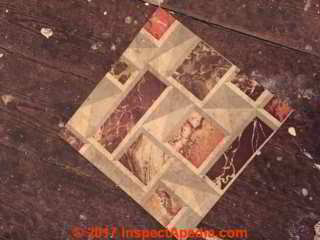 Question: Does this old 9x9 floor tile in our Glasgow Home contain asbestos?
Question: Does this old 9x9 floor tile in our Glasgow Home contain asbestos?
was hoping you might be able to tell me if this vinyl tile which was placed over our oak floor boards could be dangerous?
I didn't realise this was a possibility until I had picked them all up. I don't recognise it from the guides so I'm hoping it's ok.
The house was built in 1890 in Glasgow, Scotland but it was converted into 2 homes some point and we don't know when, more than 40 years ago, possibly 50 years, we don't know.
The tiles are 9x9 inches and we have no idea how to date them. - Anonymous by private email 2017/11/08
Reply:
I've not seen the pattern in your Glasgow flooring. I'll post it here to invite comment from other readers may have seen it. Readers: use the page top or bottom CONTACT link to send us email or use the page bottom Comments box on this page.
Most-often vinyl floor tiles like the one you sent date from the 1970's or later. Sometimes a search of magazine ads from the period will help us find a floor pattern, as might a research of flooring distributors in Glasgow from say 1950 - 1980
Question: has this 1950s Council House Lino exposed us to dangerous levels of asbestos?
My partner and I are renovating a 1950’s council house and found Lino type material upstairs and before realising started to remove two rooms worth.
We now think this may be asbestos and worry that we’ve been exposed to a dangerous level. - Anonymous by private email 2020/03/03
Reply:
Right, some asphalt-felt-impregnated paper flooring backer did contain asbestos.
If you can remove it without chopping, sanding, grinding, etc, that is by rolling it up rather intact, the risk of release of particles is likely very small.
If worry is itself making you ill, have a sample of the flooring tested and have a representative sample of settled dust from your council house interior tested for asbestos.
1955-60 Asbestos-Containing Flooring in the U.K.
On 2021-03-16 by Becca - 1950s dark red asphalt-based U.K. floor tiles probably contain asbestos
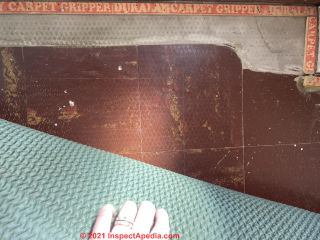 thank you so much for your help.
thank you so much for your help.
On 2021-03-15 by (mod) - dark red asphalt-asbestos floor tiles in the U.K.
@Becca,
OK so 1950s, UK, probably asphalt-asbestos floor tiles.
You can remove the carpet but you'll want to cover the floor with new carpet OR paint it with an epoxy floor paint as a sealer - as we describe at
ASBESTOS FLOORING LEFT IN PLACE
More U.K. asbestos-containing floor tile examples can be seen
at AMITCO ASBESTOS FLOOR TILES
On 2021-03-15 by Becca
I’m UK based and the house is 1950s. It is a red colour and probably about 9 inch square. There are green ones currently exposed in a porch too.
On 2021-03-15 - by (mod) -
@Becca,
with no other information about you home, the best guess one can make about whether or not your floor tiles contain asbestos is described at
DOES THIS FLOOR CONTAIN ASBESTOS? - 5 easy questions to tell if your FLOOR probably contains asbestos
but I can add that that 9-inch (?) red asphalt- based tile is likely to be an asbestos-containing flooring if it was installed in the U.K., Canada, or in the United States if installed before 1986. In other countries the key years are different.
On 2021-03-15 by Becca
Hi, I’m trying to figure out if this flooring [photo above of dark red U.K. asphalt- based floor tiles - Ed.] is asbestos tiles or not. Any help appreciated. We’ve recently moved into the property and one of the carpets has carpet moths so we’d quite like to remove the carpet but won’t if this is likely asbestos tiles. Thanks, Becca This Q&A were posted originally
at ASBESTOS FLOOR TILE IDENTIFICATION COLOR KEY
Reader Question: Do you think these U.K. floor tiles contain asbestos?
I've come across your useful website and would be really grateful if you might be able to answer some questions? The questions related to a house that we have just put an offer on. We are based in the U.K.
Firstly, I was wondering if you'd be able to confirm my suspicions that the following floor tiles might contain asbestos? - [Anon by private email, 12 Aug 2015
Asphalt & vinyl asbestos UK Flooring from 1955-1959
Both bedrooms contain this flooring:
Kitchen flooring (U.K. 1955-59)
Bathroom flooring (U.K. 1970's)
Reply: treat older UK vinyl & asphalt based floor tiles as presumed to contain asbestos
Yes especially those darker floor tiles that look like asphalt-based flooring.
What can you tell me about the building location, age, and probable floor covering age?
Reader follow-up:
... the building is located in London and we believe that it was constructed sometime between 1955 and 1959.
Pretty much everything in the flat is very close to original and we're pretty sure that all the darker flooring is original. I'm not sure about the kitchen flooring (i.e. whether grey like that was a 50s colour) and the flooring in the bathroom looks to be 70s I'd say.
Reply:
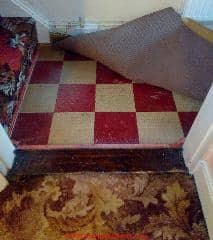 The UK Asbestos (Prohibitions) (Amendment) regulations came into force on November 24, 1999 (The E.U. followed in 2004). Chrysotile (white asbestos) had been permitted in the UK. Amosite and crocidolite forms of asbestos were banned in in the U.K. in 1985.
The UK Asbestos (Prohibitions) (Amendment) regulations came into force on November 24, 1999 (The E.U. followed in 2004). Chrysotile (white asbestos) had been permitted in the UK. Amosite and crocidolite forms of asbestos were banned in in the U.K. in 1985.
Statutory Instrument No. 2373 banned the import of crude fiber, flake, powder or waste chrysotile and the new use of asbestos cement, boards, panels, tiles and other products.
Chrysotile-containing products installed prior to November 24, 1999 could remain in place until they reached the end of their service life.
The sale of second-hand asbestos cement products and building materials with asbestos-containing coatings was forbidden. - excerpted and paraphrased from : Kazan-Allen. L. United Kingdom Bans Chrysotile. British Asbestos Newsletter, Issue 36: Autumn 1999.
Given that the U.K. didn't completely ban asbestos until 1999 though most forms were banned in 1985 - about the same period as in North America: my advice follows:
For buildings with floor tiles or sheet flooring that can be assumed to have been installed in the U.K. before 1999 it would be prudent to treat the flooring as "PACM" or "Presumed Asbestos Containing Material".
That does not mean we should panic nor undertake an expensive and dangerous asbestos removal project.
Asbestos is safe and legal to remain in homes or public buildings as long as the asbestos materials are in good condition and the asbestos can not be released into the air.
Generally the safest approach is to leave such flooring alone and to cover it over with a coating or with another layer of flooring.
On any of our asbestos-related InspectApedia pages, at CONTINUE READING you will find a complete ARTICLE INDEX to ASBESTOS HAZARDS
See in that list of articles these two in particular:
ASBESTOS FLOORING HAZARD REDUCTION
ASBESTOS FLOORING REMOVAL GUIDE
IF you are faced with a requirement for demolition and if you are uncertain about the flooring's asbestos content and cannot identify it through our guides, then you have a sample tested.
See more U.K. asbestos-containing floor tile examples
at AMITCO ASBESTOS FLOOR TILES
Reader follow-up: how to handle damaged but adhered asbestos-suspect floor tiles
... do you think that the damaged tile looks to be heading towards a friable state? All other examples of damaged tiles that I've seen look to be split in a brittle 'candy' manner or completely loose from there backing, whereas this is more dented / worn.
It'd be great if I could just fill the damage and then floor over it. I think it's the only damaged tile that we could find in the place. - J.J. 13 Aug 2015
Reply:
You will want to remove tile fragments that are not adhered to the floor below, then you can use a filler, floor leveling compound, or install a layer of solid underlayment then flooring tiles or sheet flooring, or underlayment paper then a floating laminate or engineered floor.
Just how you treat that floor surface (sealer, leveling compound, cover with underlayment, cover with rosin paper) depends on what type of new floor you intend to install over-top the old asbestos-containing flooring.
Detailed suggestions are at the floor hazard reduction and floor removal article links just above. To be clear, if the broken or cracked floor tiles are still well bonded to the subfloor below you can leave them in place.
Reader Question: What should I Do about this 1960 UK Flooring that Contains Chrysotile Asbestos?
I recently purchased a home in UK that was built in 1960 . The pre-purchase survey indicated that the tiles in the kitchen likely contained asbestos. We later had an asbestos survey done and the lab results confirmed that the tiles contained chrysotile. He said it was very low risk.
Today, a gas engineer came by to disconnect and cap the gas pipe to an old, unused cooker. The pipe was very hard to remove and the cooker moved a bit on the ground and scratched the floor tiles.
When I noticed it I took a damp paper towel and put it on top of it.
After the engineer left, I decided to vacuum the paint that came off the gas pipe when it was removed. To my horror, a loose asbestos tile lifted and stuck to the end of the vacuum hose. It may have come loose when the person dropped their wrench.
I immediately turned off the vacuum and covered the tile with a wet paper towel. When I returned home, I cleaned the vacuum outside and noticed a one square inch piece fell out of the tube.
This is where the piece came off:
I have two questions.
- Based on the pictures above, how dangerous is the exposure? I didn't expect the tile to come off so I didn't wear any protection.
- Should I get rid of the vacuum?
If this question requires a payment, I can do that. Thanks for your help.
- Anonymous by private email 2017/03/02
Reply:
OPINION: The small amount of damage shown in your photos (scrape and a broken section of flooring) are not, in my opinion, likely to produce a detectable level of airborne asbestos in your home. That's also the case for handling a single piece of flooring that broke away.
For peace of mind, I would damp wipe the vacuum exterior, remove, bag and dispose of the vacuum's interior bag, damp wipe the vacuum interior, dispose of the wipes, and install a new vacuum cleaner bag. Rinse the vac hose if it's a plastic hose that can be so treated.
For still more peace of mind, if you want to be still more meticulous, dispose of each damp wipe as it's wiped, don't use the same wipe over again on multiple surfaces, and first run the vac outdoors to let any remaining dust blow outside. It's doubtful that even that will produce a detectable / hazardous level of dust.
If the remaining flooring is sound, and if you avoid chopping, grinding, sanding, or otherwise making a dusty mess, the floor is best left alone - that's the safest approach .
See also ASBESTOS FLOORING LEFT IN PLACE
Reader Question: How can I Submit a Floor Tile Photo for Identification
(Apr 3, 2014) Anonymous said:
How can I submit a photo of a tile to see if it might contain asbestos?
Reply:
Sure, Anon, just use the email found at our CONTACT link seen at the top or bottom of any InspectApedia.com page - but it may not be necessary.
If you've got vinyl or asphalt floor tiles installed before the early 1980's it would make sense to treat them as presumed to contain asbestos (PACM or "Presumed Asbestos Containing Material") - and to avoid making a dusty demolition, sawing, grinding mess.
If you have tried looking through our example flooring photos by year or flooring manufacturer and were unable to identify your flooring then feel free to CONTACT US to send along photos and a description (age, dimensions, building history) of flooring that you are unable to identify.
Asbestos is safe and legal to remain in homes or public buildings as long as the asbestos materials are in good condition and the asbestos can not be released into the air
- Please, before sending us email asking to identify floor tiles, sheet flooring, linoleum, etc. try using our
ASBESTOS FLOORING IDENTIFICATION procedure or our photo catalog of floor tiles and sheet flooring that may contain asbestos
beginning at ASBESTOS FLOOR TILE IDENTIFICATION PHOTOS 1949-1959 - For identification guides to all brands of asphalt asbestos, vinyl asbestos, and similar flooring products see FLOOR TILE / SHEET FLOORING PHOTO GUIDES - list of photo guides
- To identify unknown flooring products:
at ASBESTOS FLOOR TILE PHOTO ID REQUESTS we include additional photographs of both tile and sheet flooring products submitted by readers with requests for more information. - To identify resilient or sheet flooring or sheet-forms of resilient flooring that may contain asbestos are now found
at RESILIENT SHEET FLOORING ID GUIDE.
Wood-Grain Pattern 9" U.K. Floor Tiles ca 1963 that Do Not Contain Asbestos
Reader inquiry about asbestos in UK floor tiles:
Recently purchased a property in London and pulled up the carpets to find these tiles. They measure 9 x 9. The property dates from 1888 and I know they were definitely laid prior to 1963.
Is it likely they contain asbestos? - Anon by private email 11/1/2017
Reply: possibly, up to 1999 flooring in the UK could contain asbestos; need lab test to know for certain
The UK Asbestos (Prohibitions) (Amendment) regulations came into force on November 24, 1999 (The E.U. followed in 2004).
So the flooring could contain asbestos but I add that in hearing from other U.K. readers, it is certainly the case that not all pre-1999 vinyl flooring in the UK contained asbestos. You'd need to have a certified asbestos test lab to know for sure.
In any event, if the floor is well-adhered, usually you can cover over the floor as an approach with the least possible hazard.... [Our original email reply contained additional advice and asbestos hard reduction article links.]
The photographs shown just above illustrate a 9" vinyl floor tile installed in a London home before 1963.
Reader follow-up: no asbestos found in this UK flooring
According our reader (Anon) who submitted these photos, later asbestos tests performed by a U.K. asbestos testing lab found that this flooring did not contain asbestos. She wrote:
Great news! No asbestos detected in tile or glue.
Still, readers dealing with older floor coverings should do what you can to avoid making a dusty mess as in any case exposure to high levels of demolition dust can be harmful, asbestos or no.
Possible Asbestos in Asphalt / Vinyl Floor Tiles in the UK 1970-1985?
On 2023-04-13 by Craig - This UK Sheet Flooring Does Not Contain Asbestos
I would like your knowledge to know what year these are from if possible please and if they're vinyl or lino?
To help:
- Note the rear 'hatched' plastic like backing material)-
- Note there was a thick distinct clear layer of plastic coating on the top which makes me feel it would be classed as Vinyl
FYI these tiles were from a UK house built in the 1930s, no idea if it was original or from a renovation.
The tiles were underneath mastic asphalt (the inch thick shiny black stuff).
See lab test results below.
[Click to enlarge any image]
There were layers and layers of mysterious stuff I needed to get tested (including the mastic asphalt previously).
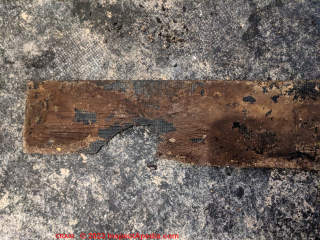
These were submitted as Sheet/Lino as I had no idea it was a tile when I simply took out a sample.
The mastic asphalt had a fibrous mat underneath it to prevent cracking I assume (thats what the insulation fibres are)
I also got the glue and cement/concrete below the vinyl sampled too whilst i was there to cover all bases.
On 2023/04/13 by (mod) [DF] - confirming probably 1970s sheet vinyl flooring with plastic mesh backer
If we're confident that that mesh backer is a plastic material, and in an older 1930s UK home, my guess would be that the flooring dates from the 1970s or later. Plastics were in use in the UK on interior walls and floors as early as the mid 1960s (Waters 1964), but vinyl sheet flooring is more a 1970s product in my OPINION.
And I agree that the clear plastic surface argues for calling this a vinyl sheet flooring or lino product, though I've seen similar patterns in asphalt-based linoleum products from the previous generation.
Plastic mesh used as a backer for sheet flooring was certainly in use by the early to mid 1970s, as noted by Floyd (1974) cited below.
It's useful to have tested the mastic as well, as asbestos was common in both actual asphalt-based mastic flooring adhesive and in later formulations that are tan in color to light cream colored, often water soluble.
Thank you for the question and photos - those will be helpful to other UK readers.
Research on First Appearance of Vinyl Sheet Flooring in the UK
- Americus. "Some new proprietary products Part 2." Pigment & Resin Technology 3, no. 6 (1974): 12-17.
Excerpt:
… Described recently in England is the first acrylic-based coating for - Baker, Michael J., and Michael J. Baker. "Product Life Cycles and Diffusion Theory." Marketing New Industrial Products (1975): 24-47.
- Floyd, K. L., and H. M. Taylor. "Industrial applications of textiles." Textile Progress 6, no. 2 (1974): 1-38.
Excerpt: … As Robbins (9) points out, the situation in which one has a brittle fibre (as opposed to a ductile fibre) supported by, and dispersed in, a high-strain plastics matrix is the reverse of the … - Waters, Eh. "Architectural Uses Of Plastics: Internal Wall And Floor Surfaces." Architectural Science Review 7, No. 1 (1964): 4-7.
On 2022-11-04 by InspectApedia (Editor) (mod) - possible asbestos in floor tiles in Wales
By building age and location and the general style of those 1970's floor tiles installed in a Wales kitchen, it's reasonable to treat the floor as presumed to contain asbestos.
IF you were not grinding or chopping up the floor and it's generally in good shape (not caring about surface paint except for a lead paint hazard), then there's not likely to be a measurable asbestos hazard from simply walking or crawling over the surface.
If it's in as good shape as your flooring photos suggest you'd leave the floor in place as safest and least costly.
See our suggestions at
ASBESTOS FLOORING HAZARD REDUCTION - live link found at Recommended Articles at the end of this page.
OPINION: if that were my floor, I'd rather spend my money on a suitable sealant and on covering that floor with new material (carpeting as you plan to install) than on testing.
On 2022-11-04 by Anonymous by private email - do these Welsh kitchen floor tiles contain asbestos?
We have moved into a partially renovated house in Wales that was probably built in the 1970s, but am not sure exactly. The floor of the old kitchen has been pulled up so that it is old tiles.
I was trying to remove a few bits of old foam backing on the tiles (from the lino/vinyl) floor bring removed, as it is a bit mouldy, when I Googled and realised that there might be asbestos. Now really worried about it as we've been using this room for months with a toddler.
Can you please give some advice about both the tiles and the bits of foam backing stuck to it from the floor above.
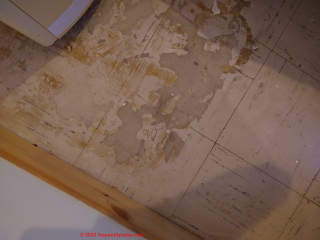
We are planning to carpet, but will that be safe with the foam attached? Should we test it? Sorry I'm just really worried and unsure what to do.
I have attached a photo of the tiles (beige/grey-ish with dark grey marble (25 cm by 25 cm - just under 10 inches by just under 10 inches), which are in reasonable condition ( only noticed one with a small dent, though others have been cut around where old kitchen oven or something must have been). Not sure if the glue was black or it's just the damp proof bitumen for house. Photo of this too.
I have also attached a photo of the left over foam backing of the lino/vinyl (beige/grey-ish with yellow glue). From old photos the upper surface looks like it was a dark green.
Thank you so much any help would be appreciated. - 2022/11/04 Anonymous by private email to Editor
Last photo - floor tiles in Wales that may contain asbestos.
On 2020-10-31 by Nathan - asbestos floor in a 1973 UK Home?
Hi, uk based house from c 1973 and I’ve found these 10x10 tiles everywhere! No visible makers mark but stuck down with a black bitumen smelling adhesive.
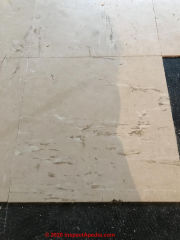
On 2020-10-31 - by (mod) -
It would be reasonable to treat that floor and mastic as presumed to contain asbestos, Nathan.
I'll move your photo and enquiry to our UK asbestos floor tile article series so as to invite helpful comments from other UK readers
Question: do these floor tiles in an older home in Kent contain asbestos?
Hello hope you can help identify these tiles I have noticed during the install of a new Carpet please see below many thanks in advance.\
I live in the UK. My house is a cottage which was originally built in the late 1800’s. I’m in Kent south east of England - 2018/06/12, anonymous by private email.
Reply:
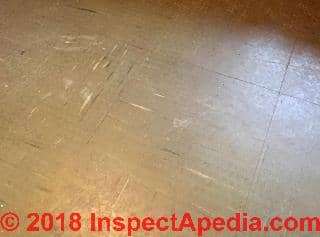 I do not recognize the exact pattern of your flooring, and can't see much of the floor tile pattern nor dimensions in your photo.
I do not recognize the exact pattern of your flooring, and can't see much of the floor tile pattern nor dimensions in your photo.
From the colour and general pattern the flooring in your photo, in a UK home, I am GUESSING that the floor would have been installed between 1965 and 1980.
As you'll read in ASBESTOS FLOORING IDENTIFICATION 1950's or LATER in the U.K. we have had reports of flooring of this type as early as 1963 that tested as "asbestos free".
Chrysotile had been the only type of asbestos permitted in the UK since amosite and crocidolite were banned in 1985.
Predominant type of asbestos used in UK Floor Tiles
Chrysotile (white asbestos) was the predominant form of asbestos used in UK floor tiles, with less-common use of tremolite and actinolite in UK asphalt-asbestos or vinyl asbestos flooring.
Chrysotile asbestos was widely used both in small powder particle form as a filler and in longer fibrous form as a strength reinforcement in both asphalt and vinyl floor tiles in many countries including the U.K. up to 1985.
Asbestos was used in some other forms in buildings in the UK up to 2000.
Although a UK vinyl or asphalt-based floor tile installed after 1985 is not likely to contain asbestos, it could, from "new old stock" for example. For that reason, for flooring that has not been tested or otherwise identified as asbestos-free, and for floors installed before 2000, my advice is to treat the floor as presumed to contain asbestos.
Question: do these floor tiles from a 1973 U.K. home contain asbestos?
I have been using your very helpful website to try and identify some floor tiles that potentially contain asbestos. I have a house that was built in 1973 and have recently removed some original floor tiles in the kitchen, I didn't realise asbestos was ever put into floor tiles and didn't realise the risk.
Most of the floor tiles are up now, however I don't want to touch them until I know for sure they are not asbestos.
They look very similar to the second set of images on your not asbestos page. https://inspectapedia.com/hazmat/Asbestos_Floor_Tile_in_UK.php#1963NotAsbestos
I was wondering if you ever found out about those? As it isn't very clear if they are likely/unlikely to contain asbestos.
I am sending a sample away for testing but wondered if you could give me peace of mind in the meantime. I can't find a similar tile on your website.
I have attached my own photos. (Sorry they are not great) - Anonymous by private email 7 June 2019
Reply:
From the tile appearance and the age that you give, it's likely that those floor tiles contain asbestos. Remember that the tile itself is not friable. It's the grinding chopping sawing or sanding the create the more serious dust hazard. The same website where you're finding those tiles how's our articles on safe cleanup procedures.
I was just emphasized hear that you should be sure not to use an ordinary vacuum cleaner that might send small particles airborne.
Do let me know your test results.
Reader follow-up: Asbestos fibres confirmed in UK floor tiles from 1973
Just had the test results back today. They do indeed contain chrysotile asbestos as does the black adhesive. - Anonymous 27 June 2019
Here is the UK FLOOR TILE ASBESTOST TEST RESULT [PDF] - [amended to protect the reader's anonymity - Ed. ]
Advice for UK Floor Tiles Installed before 1986
For buildings with floor tiles that could be assumed to have been installed in the U.K. before 1986 it would be prudent to treat the flooring as "PACM" or "Presumed Asbestos Containing Material".
The presence of known asbestos-containing flooring does not mean we should panic nor that we should undertake an expensive and dangerous asbestos removal project.
Asbestos is safe and legal to remain in homes or public buildings as long as the asbestos materials are in good condition and the asbestos can not be released into the air.
Generally the safest approach is to leave such flooring alone and to cover it with a coating or with another layer of flooring.
See ASBESTOS FLOORING HAZARD REDUCTION.
If your floor is basically undamaged and well-secured to the subfloor or slab below, I would consider coating it with an epoxy sealant
(see ASBESTOS FLOORING LEFT IN PLACE) or simply covering it with new sheet flooring.
If other areas of your floor (not shown in your photos) are crumbling, badly damaged, or absolutely must be removed for other reasons,
see ASBESTOS FLOORING REMOVAL GUIDE
IF you are faced with a requirement for demolition and if you are uncertain about the flooring's asbestos content and can not identify it through our guides, then you have a sample tested.
In that case see ASBESTOS TESTING LAB LIST
IF you are faced with a requirement for demolition and if you are uncertain about the flooring's asbestos content and cannot identify it through our guides, then you have a sample tested.
...
Reader Comments, Questions & Answers About The Article Above
Below you will find questions and answers previously posted on this page at its page bottom reader comment box.
Reader Q&A - also see RECOMMENDED ARTICLES & FAQs
On 2024-01-28 by InspectApedia Publisher - 1960s or 1970s floor tile that indeed might contain asbestos
@Charlene,
That looks like 1960s or 1970s floor tile that indeed might contain asbestos.
But don't panic - the worry is almost certainly a greater health hazard than the flooring, As long as the floor is in good condition, not crumbling, making dust, and as long as you're not disturbing it by demolition, the hazard level from walking on or sitting on the floor is likely to be well below the limits of detection,
Please read through ASBESTOS FLOORING HAZARD REDUCTION
for inexpensive steps you can take to reduce the risk even further.
Let me know what questions remain.
Daniel
On 2024-01-28 by Charlene
We removed the carpet a long time ago as we was doing works at our property. We haven't been able to cover the floor as it's so expensive . I didn't realise it may contain asbestos and the kids have been playing on it!
Please help I'm worried sick! House built in 1970s.
On 2023-04-09 by InspectApedia Editor - UK 1950s asphalt-asbestos floor tiles
@Midge,
Those look like 1950s asphalt-asbestos floor tiles.
See the photo of brown asphalt asbestos floor tiles from Armstrong's 1954 catalog found at
BEIGE, BROWN, OR WOOD-TONE ASBESTOS FLOOR TILES
https://inspectapedia.com/hazmat/Beige-Brown-Tan-Floor-Tile-Asbestos.php
In my OPINION if the tiles are in good condition and well-adhered you do not need to remove them.
If you want to keep using that floor and do not want to simply cover it with a new flooring layer (safe and economical option), then you can, after cleaning as you've done, seal the floor surface to protect it from abrasion.
I've used clear floor coatings of various sorts, ranging from epoxy floor coatings (permanent, perhaps more shiny than you want) to semigloss polyurethane.
Simply waxing the floor doesn't offer much protection.
On 2023-04-09 by Midge D
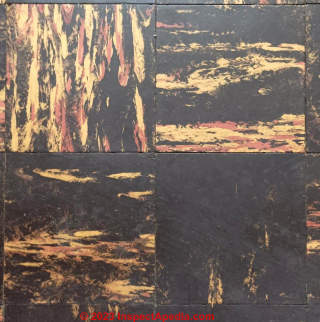 Hi, I live in Birmingham (UK), I've just taken up the carpets in our 1950's built house and found these (I have a vague memory of them being exposed late 60s early 70s), I've 'helpfully' been informed that they may contain asbestos.
Hi, I live in Birmingham (UK), I've just taken up the carpets in our 1950's built house and found these (I have a vague memory of them being exposed late 60s early 70s), I've 'helpfully' been informed that they may contain asbestos.
They're very Dark Reddish Brown with a yellow/ Orange marble effect, similar to an earlier posted Becca (or US Armstrong) design.
Ceramic in feel (Asphalt?) there's a couple of small chipped bits where I took up the gripper rods, they don't appear to be stuck down with mastic.
I do like them and have cleaned the underlay grime off with non abrasive cleaner. I'll be jiggered if I can afford to have them removed.
Any clues to their provenance, hazardousness??
T.i.a Midge
On 2023-03-30 by InspectApedia Editor - use a combination of damp-wiping and HEPA vacuuming to clean all of the surfaces of concern
@Jay,
There is absolutely no need to "throw everything away" even if there is a concern that dust from the work you are discussing disturbed asbestos-containing materials.
More properly, a cleaning contractor should use a combination of damp-wiping and HEPA vacuuming to clean all of the surfaces of concern.
If a pot or pan or fork or glass seems dust to you, such items can simply be washed in a sink or in a dishwasher.
Let us know more about how this works out for you and don't hesitate to ask more questions if needed.
On 2023-03-30 by Jay
@InspectApedia Editor , there is another picture of the floor, they have removed most of the tiles and there’s dust around the kitchen due to the work they’ve done. I am very worried to even use anything from the kitchen at the moment and I want to throw everything away but I can’t afford that
On 2023-03-30 by InspectApedia Editor - Without more information, best to treat them as presumed asbestos containing material (PACM)
@jay,
Without more information, best to treat them as presumed asbestos containing material (PACM). Take a look at the live link in the Recommended Articles list above for
DOES THIS FLOOR CONTAIN ASBESTOS? - 5 easy questions to tell if your FLOOR probably contains asbestos
The safest and simplest thing to do is to leave the flooring in place and cover with new flooring or seal it. In that same list of articles see our discussion on
ASBESTOS FLOORING HAZARD REDUCTION
and if you do need to remove it, see
ASBESTOS FLOORING REMOVAL GUIDE
On 2023-03-30 by jay
Do they look like they could contain asbestos? The house was built in early 1900’s-1930 and we came across these.
Theyre I’m bad condition some are chipped and broken but also contractors did work without mentioning asbestos. We came across it ourselves. Have you seen any like that thanks
On 2023-03-27 by InspectApedia Editor
@Worried,
That looks very similar to a couple patterns that we list at
BEIGE, BROWN, TAN OR WOOD-TONE ASPHALT ASBESTOS & VINYL ASBESTOS FLOOR TILES
Although we don't have asbestos percentage information on them, the pattern name may give you a start.
Keep in mind that the simplest and safest way to handle the flooring is to leave it in place and cover with new flooring or seal it.
Among other articles in our Recommended Articles list just above on this page, see
ASBESTOS FLOORING HAZARD REDUCTION
On 2023-03-27 by Worried
Hello - these floor tiles are known from a survey to be ACMs but I wondered if you could identify them so as to ascertain the possible percentage of asbestos? The property is a council flat, very likely built in 1950s/1960s. Many thanks.
On 2023-03-03 by InspectApedia Editor - floor backer appears to be asphaltic - some of those contained asbestos
@Tom,
Thank you for the UK lino photo and question.
That floor backer appears to be asphaltic - some of those contained asbestos. And it's in brittle, crumbly condition, so if you have to remove it you'd either treat it as presumed to contain asbestos, or have a sample tested.
If you can leave it in place and cover it over, that's safest and least costly.
Watch out: we see plenty of debris where you've uncovered the older wood flooring and what looks like a couple of layers of floor material. Don't try cleaning that up with a shop vac without first confirming that there's no asbestos. You'd need to use a HEPA-rated vacuum cleaner to be safer.
In the list of Recommended Articles just above on this page, see:
DOES THIS FLOOR CONTAIN ASBESTOS? - 5 easy questions to tell if your FLOOR probably contains asbestos
Also, before doing any more demolition, read the advice given above in these two articles in the same list:
ASBESTOS FLOORING REMOVAL GUIDE
ASBESTOS REMOVAL, WETTING GUIDELINES
After reviewing those articles, let us know if you have additional questions.
On 2023-02-27 by Tom
Hi, I've found this lino-like flooring beneath the underlay in my house. The house was built in 1903, so would have likely had new flooring at a few points in time. Not sure if I should get this tested or not?
On 2022-11-29 by InspectApedia Publisher - U.K. floor tiles may indeed contain asbestos
@Richphilp116,
Those U.K. floor tiles may indeed contain asbestos. The floor is safe and legal if it is in good condition and you are not damaging it by chopping, grinding, sanding, etc. but safest if you cover it over with new material.
On 2022-11-29 by Richard p
This is a single sheet, falls apart if you try to roll it up (I'm wearing suitable PPE, do you think it's asbestos? The underlay seems to be wool or insulation, could also be asbestos?
Found under carpet, one single sheet for the room. Is it dangerous? Downstairs has other tiles but they are individual and grey
On 2022-10-17 by InspectApedia-911 (mod) - in the UK, cover the asbestos-suspect floor with a layer of new material
@Sharon,
Try not to let the worry run away with you is that maybe more hazardous to your health than the flooring itself.
This is a well-known and long established topic for which there are easy and well-documented remedies discussed here on this website as well as elsewhere.
Basically. if the flooring contains asbestos, the best, safest, most expert recommended, and least expensive remedy is to cover the floor with a layer of new material.
In the Recommended Articles list on this page, see
ASBESTOS FLOORING HAZARD REDUCTION for suggestions to minimize any asbestos hazard.
On 2022-10-17 by Sharon
I did not realise that tiles and adhesive could contain asbestos and have tried to remove. Sample sent for confirmation. I am worried sick
On 2022-10-14 by InspectApedia (mod) - Victorian house tiles may contain asbestos
@Alan Findlay,
For any dust that may remain from the removed tiles, damp wipe and use a HEPA vacuum to clean it up.
The easiest and safest thing to do with suspect asbestos flooring is to leave in place and cover with new flooring or seal it with one the sealants we discuss in this article series.
In the Recommended Articles list just above on this page, as a start, see
ASBESTOS FLOORING HAZARD REDUCTION
More definitive information can be determined by answering 5 simple questions, also found in the Recommended Articles list.
On 2022-10-14 by Alan Findlay
Have found some 12 inch square vinyl tiles under vinyl sheet. Occurred that they may contain asbestos. They broke up using a scraper. Is it likely that they contain asbestos?
Is there a significant risk having only lifted around 4 tiles. Note the floor where tiles removed is actually concrete coloured but has been dampened. It is a Victorian house but in an extension where a toilet was installed some time ago.
On 2022-10-05 by InspectApedia-911 (mod)
Apologies I accidentally deleted the post that I'm replacing below and it would be helpful if you could repost your photo else will do what we can to fix it later today.
About the flooring and your photo that I have accidentally deleted with my clumsy fingers, you'll see above at the start of the article on this page that in the UK flooring manufactured after 1985 would not be expected to contain asbestos.
AUTHOR: Ross N (no email)
COMMENT: @InspectApedia-911,
Hi, yes I’d like to know if it’s presumed this flooring might contain asbestos. I can’t seem to find an answer suggesting one way or the other.
...
Continue reading at U.K. FLOOR TILES AFTER 1985 BEFORE 2000 or select a topic from the closely-related articles below, or see the complete ARTICLE INDEX.
Or see ASBESTOS FLOOR TILE IDENTIFICATION 1950's or LATER - UK FAQs - questions and answers about UK flooring asbestos posted originally on this page.
Or see these
Recommended Articles
- ASBESTOS FLOORING HAZARD REDUCTION
- ASBESTOS FLOORING IDENTIFICATION
- ASBESTOS FLOORING IDENTIFICATION GUIDE INDEX - all brands, all years
- ASBESTOS FLOORING REMOVAL GUIDE
- ASBESTOS REMOVAL, WETTING GUIDELINES
- ASBESTOS RISK ASSESSMENT
- ASBESTOS TEST RESULTS for TILE & SHEET FLOORING
- ASBESTOS TESTING LAB LIST
- DOES THIS FLOOR CONTAIN ASBESTOS? - 5 easy questions to tell if your FLOOR probably contains asbestos -
- U.K. ADVICE for POSSIBLE-ASBESTOS FLOORING
- U.K. ASBESTOS REGULATIONS
- U.K. ASBESTOS FLOOR TILE COMPOSITION
- U.K. ASBESTOS FLOORING IDENTIFICATION 1950's or LATER in the U.K
- U.K. FLOOR TILES AFTER 1985 BEFORE 2000
- U.K. FLOOR TILES 9x9" 1985 NOT ASBESTOS
Suggested citation for this web page
ASBESTOS FLOORING IDENTIFICATION 1950's or LATER in the U.K. at InspectApedia.com - online encyclopedia of building & environmental inspection, testing, diagnosis, repair, & problem prevention advice.
Or see this
INDEX to RELATED ARTICLES: ARTICLE INDEX to ASBESTOS HAZARDS
Or use the SEARCH BOX found below to Ask a Question or Search InspectApedia
Ask a Question or Search InspectApedia
Questions & answers or comments about how to identify asbestos-containing flooring materials and what to do when asbestos-containing floor tiles or sheet flooring are found in a building.
Try the search box just below, or if you prefer, post a question or comment in the Comments box below and we will respond promptly.
Search the InspectApedia website
Note: appearance of your Comment below may be delayed: if your comment contains an image, photograph, web link, or text that looks to the software as if it might be a web link, your posting will appear after it has been approved by a moderator. Apologies for the delay.
Only one image can be added per comment but you can post as many comments, and therefore images, as you like.
You will not receive a notification when a response to your question has been posted.
Please bookmark this page to make it easy for you to check back for our response.
IF above you see "Comment Form is loading comments..." then COMMENT BOX - countable.ca / bawkbox.com IS NOT WORKING.
In any case you are welcome to send an email directly to us at InspectApedia.com at editor@inspectApedia.com
We'll reply to you directly. Please help us help you by noting, in your email, the URL of the InspectApedia page where you wanted to comment.
Citations & References
In addition to any citations in the article above, a full list is available on request.
- "Asbestos Floor Tile Removal", the University of Minnesota's advice on removing VAT (vinyl asbestos or asphalt asbestos floor tile) can be read in detail at www.health.state.mn.us/divs/eh/asbestos/floortile/index.html
- Asbestos Regulations: State asbestos regulatory agencies (5 pp, 17k) (original source http://www.epa.gov/asbestos/pubs/statecontactsapril2009.pdf ) for information on how to find an accredited asbestos professional.
- Asbestos products and their history and use in various building materials such as asphalt and vinyl flooring includes discussion which draws onASBESTOS, ITS INDUSTRIAL APPLICATIONS, ROSATO 1959, D.V. Rosato, engineering consultant, Newton, MA, Reinhold Publishing, 1959 Library of Congress Catalog Card No.: 59-12535 (out of print).
- MANAGING ASBESTOS in PLACE: A Building Owner's Guide to Operations and Maintenance Programs for Asbestos-Containing Materials ("Green Book"), web search 08/11/2010, original source: http://www.epa.gov/asbestos/pubs/management_in_place.html
How to Develop and Maintain a Building Asbestos Operations and Maintenance (O&M) Program, This information is designed to assist building owners and managers in understanding how to develop and maintain an operations and maintenance program for asbestos-containing materials in their buildings. - "Asbestos Floor Tile Removal Guide & Instructions - copy on file as Asbestos_Floor_Tile_Removal_MDH.pdf ] - ", Minnesota Department of Health, retrieved 12/7/2010, original source: http://www.health.state.mn.us/divs/eh/asbestos/floortile/index.html
- In addition to citations & references found in this article, see the research citations given at the end of the related articles found at our suggested
CONTINUE READING or RECOMMENDED ARTICLES.
- Carson, Dunlop & Associates Ltd., 120 Carlton Street Suite 407, Toronto ON M5A 4K2. Tel: (416) 964-9415 1-800-268-7070 Email: info@carsondunlop.com. Alan Carson is a past president of ASHI, the American Society of Home Inspectors.
Thanks to Alan Carson and Bob Dunlop, for permission for InspectAPedia to use text excerpts from The HOME REFERENCE BOOK - the Encyclopedia of Homes and to use illustrations from The ILLUSTRATED HOME .
Carson Dunlop Associates provides extensive home inspection education and report writing material. In gratitude we provide links to tsome Carson Dunlop Associates products and services.




